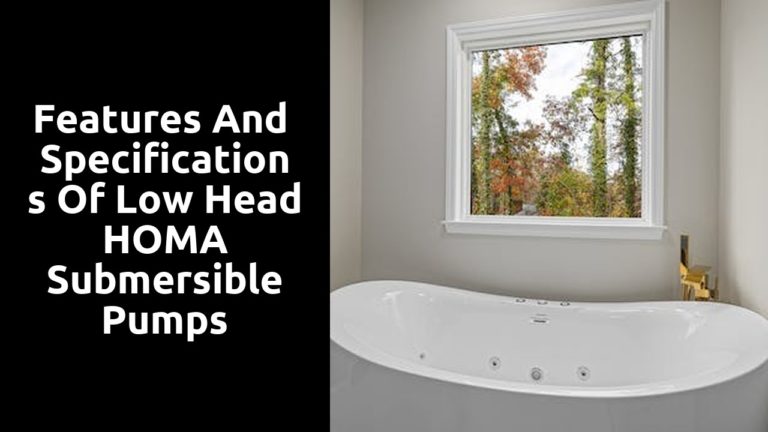Best Sump Pump for Septic Systems
Understanding the Role of a Sump Pump in Septic Systems
A sump pump plays a crucial role in the functioning of septic systems, ensuring proper drainage and preventing potential issues. One of its primary functions is to collect and remove excess water from the sump pit, which is a hole dug below the floor level of the basement or crawlspace. This water can accumulate due to natural groundwater movement or heavy rainfall. By pumping out this excess water, the sump pump helps in preventing the flooding of the basement or crawlspace, thus providing protection against water damage. Additionally, the sump pump helps maintain the appropriate water level in the septic tank, ensuring its optimal performance.
In septic systems, the sump pump also aids in preventing water from seeping into the drain field, which could lead to the saturation and potential failure of the system. By effectively diverting excess water away from the drain field, the sump pump helps to maintain the proper balance within the septic system. This helps to prevent any potential issues, such as odors, backups, or damage to the drain field. Overall, the role of a sump pump in septic systems is essential for the efficient and reliable operation of the entire system, safeguarding both the property and the surrounding environment.
Factors to Consider When Choosing a Sump Pump for Septic Systems
Factors to Consider When Choosing a Sump Pump for Septic Systems
When it comes to choosing a sump pump for septic systems, there are several important factors to keep in mind. Firstly, the horsepower of the pump is crucial. A higher horsepower will ensure that the pump can effectively handle the volume of water and solid waste that may be present in a septic system. Additionally, considering the durability of the pump is essential. Septic systems can be prone to debris and other potentially damaging materials, so opting for a pump that is constructed with strong and long-lasting materials is advisable. Noise level is another factor to consider, as some pumps can be quite noisy and may cause disturbance if located close to frequently used areas. Opting for a quieter pump will minimize potential disruptions in your home.
Another important consideration is the type of float switch the pump has. Float switches are responsible for activating the pump when the water level reaches a certain point. An adjustable float switch provides greater control over when the pump is activated, allowing for more efficient water removal. On the other hand, a tethered float switch may require a larger pit or sump basin to operate properly. Therefore, it is crucial to assess the size and specifics of your septic system before deciding on the type of float switch to choose. Lastly, it is recommended to consider the warranty and customer reviews of the sump pump. A reliable warranty will provide peace of mind knowing that any potential issues can be addressed, while customer reviews can offer insights into the reliability and performance of different models. By considering these factors carefully, you can ensure that you choose a sump pump that is suitable for your septic system’s specific needs.
The Importance of Proper Sizing for a Sump Pump in a Septic System
Proper sizing of a sump pump is of utmost importance when it comes to maintaining the functionality and efficiency of a septic system. Without the correct size, a sump pump may not be able to adequately handle the volume of water that needs to be pumped out of the system, leading to potential backups and overflows. This can result in costly repairs, unpleasant odors, and even environmental hazards.
When selecting a sump pump for a septic system, it is essential to consider the specific characteristics of the system, such as the size of the tank, the average water consumption, and the soil absorption capacity. These factors will help determine the appropriate flow rate and pumping capacity required for the sump pump. If a pump is too small, it may not be able to effectively remove water during heavy rainfall periods or during times of increased water usage. On the other hand, an oversized sump pump may waste energy and lead to premature wear and tear. Therefore, selecting the right size of sump pump ensures optimal functioning and helps avoid potential issues down the line.
Different Types of Sump Pumps Suitable for Septic Systems
There are several types of sump pumps available in the market that are specifically designed to be suitable for septic systems. One such type is the submersible sump pump. As the name suggests, these pumps are designed to be completely submerged in the sump pit, which makes them ideal for septic systems. Submersible sump pumps are typically more reliable and efficient compared to other types, as they are designed to handle heavy-duty tasks and can expel a larger volume of water. This is crucial for septic systems, as they often need to handle large amounts of water during heavy rainfall or flooding. Additionally, submersible sump pumps are designed to have a longer lifespan and require less maintenance, which is a great advantage for septic system owners.
Another type of sump pump suitable for septic systems is the pedestal sump pump. Unlike submersible pumps, pedestal pumps are not submerged in water, but instead, they have a motor that sits on a pedestal above the sump pit. This design makes pedestal pumps easier to access and service, as they don’t need to be pulled out of water for maintenance. They are also typically less expensive compared to submersible pumps. However, pedestal pumps might not be as efficient in expelling large amounts of water as submersible pumps. Therefore, if your septic system regularly deals with heavy water flow, a submersible sump pump might be a more suitable choice.
Key Features to Look for in a Sump Pump for Septic Systems
When it comes to selecting a sump pump for septic systems, there are a few key features that you should consider. First and foremost, it is essential to choose a pump that has a powerful motor. A strong motor ensures that the pump can handle the volume of water and waste that may be present in the septic system. Look for a pump with a motor that has at least 1/3 horsepower or more, as this will provide the necessary strength to effectively pump out the effluent.
Another important feature to look for in a sump pump for septic systems is a durable construction. Septic systems can be harsh environments, with corrosive chemicals and debris often present. Therefore, it is crucial to select a pump that is made from materials such as stainless steel or cast iron, which can withstand the corrosive effects of the septic system. Additionally, consider a pump that is designed with a solid and sturdy build to ensure it can withstand the rigors of continuous operation.
Furthermore, it is beneficial to choose a sump pump that has a high pumping capacity. The pumping capacity, often measured in gallons per hour (GPH), refers to the amount of water the pump can remove within a specific time frame. A pump with a higher pumping capacity will be more efficient at removing water and waste from the septic system, helping to prevent backups and overflows. Look for a pump with a GPH rating that suits the needs of your septic system, considering factors such as the number of occupants in your home and the overall size of the septic tank.
Lastly, consider a sump pump that incorporates additional safety features such as an alarm system or a battery backup. These features can provide an added layer of protection in case of power outages or mechanical failures. An alarm system will notify you of any issues with the pump, allowing for timely maintenance or repairs, while a battery backup ensures that the pump can continue operating during power disruptions.
In conclusion, when selecting a sump pump for septic systems, it is crucial to consider features such as a powerful motor, durable construction, high pumping capacity, and additional safety features. By choosing a pump with these key features, you can ensure the proper functioning of your septic system and minimize the risk of backups or overflows.
Tips for Installing a Sump Pump in Your Septic System
A proper installation of a sump pump in your septic system is crucial for its efficient functioning and prevention of any potential issues. Here are a few essential tips that can guide you through the installation process. Firstly, it is imperative to choose the right location for the sump pit. The ideal spot should be in a well-ventilated area and away from any potential obstructions such as trees or buildings. Additionally, it is important to ensure that the sump pit is positioned at a lower level than the septic tank to allow the waste materials to flow naturally. Taking these precautions will ensure that the sump pump operates effectively and prevents any sewage backup or flooding.
Moreover, selecting the appropriate sump pump for your septic system is equally important. Consider factors like the size and capacity of the pump, as well as the amount of waste your septic system produces. Opting for a pump with a higher horsepower may be necessary for larger systems or those with heavier waste loads. Additionally, choose a pump with a built-in alarm system that can alert you in case of any malfunction or high water levels. Regular maintenance and inspection of the sump pump should also be carried out to identify any potential issues before they become major problems. Adhering to these tips will help ensure a smooth installation and optimal performance of your sump pump in your septic system.
Maintaining and Troubleshooting Your Sump Pump in a Septic System
Maintaining and Troubleshooting Your Sump Pump in a Septic System:
Your sump pump plays a crucial role in keeping your septic system functioning efficiently. To ensure proper maintenance, it is important to conduct regular inspections and address any issues promptly. One key aspect of maintaining your sump pump is cleaning out the debris that may accumulate in the pump pit. This can be easily done by removing any leaves, dirt, or other debris that may have found their way into the pit. In addition to regular cleaning, it is also important to test your sump pump periodically to ensure it is in good working condition. Activate the pump by pouring water into the pit and observe if it is effectively pumping water out. If you notice any signs of malfunction, such as strange noises or a failure to pump water, it may be necessary to troubleshoot the pump.
When troubleshooting your sump pump, it is best to start by checking the power source. Ensure that the pump is properly connected to a functioning electrical outlet and that the circuit breakers have not been tripped. If the power supply is not the issue, it is time to inspect the pump itself. Check for any visible signs of damage, such as leaks or clogs. Additionally, examine the float switch and ensure it is not obstructed or stuck. If all else fails, it may be necessary to contact a professional to assess and repair any more complex issues with your sump pump. Remember, regular maintenance and prompt troubleshooting will help keep your septic system running smoothly, avoiding potential backups and costly repairs.
How a Backup Sump Pump Can Provide Extra Protection for Your Septic System
A backup sump pump is a valuable addition to any septic system as it provides an additional layer of protection against potential disasters. When heavy rains or power outages occur, the primary sump pump may fail, leaving your septic system vulnerable to damage from flooding or backups. This is where a backup sump pump steps in, seamlessly taking over when the primary pump is unable to function. By continuously monitoring the water levels and activating automatically when needed, the backup sump pump ensures that excess water is efficiently removed from your septic system, preventing any potential overflow or contamination.
Furthermore, a backup sump pump offers peace of mind, knowing that even during emergency situations, your septic system is safeguarded from potential harm. With its reliable functionality and ability to operate independently of the primary pump, this backup system acts as an insurance policy against unexpected events. It is particularly beneficial in areas prone to extreme weather conditions or power fluctuations. By investing in a backup sump pump, you can rest assured that your septic system is well-protected, reducing the risk of costly repairs and environmental damage.
Comparing the Cost and Efficiency of Various Sump Pumps for Septic Systems
Sump pumps play a crucial role in septic systems, helping to prevent water accumulation and potential flooding. When comparing the cost and efficiency of various sump pumps available in the market, several factors ought to be considered. One of the primary factors is the horsepower of the pump. Higher horsepower pumps generally have a greater capacity to move water, making them suitable for larger septic systems or areas prone to heavy rainfall. However, it’s essential to strike a balance between horsepower and energy usage, as higher horsepower often means higher operating costs.
In addition to horsepower, the type of pump and its construction materials should also be taken into account. The two main types of sump pumps are submersible and pedestal pumps. Submersible pumps are placed directly in the sump pit and are completely underwater, while pedestal pumps are positioned above the waterline. Submersible pumps are typically more efficient and quieter but come with a higher price tag. Furthermore, the choice of construction materials can impact both the cost and durability of the pump. Cast iron pumps tend to last longer and are less likely to corrode compared to pumps made of plastic or stainless steel. However, it is important to consider the cost-benefit analysis and evaluate one’s specific needs when making a selection.
Expert Recommendations for Selecting the Right Sump Pump for Your Septic System
When it comes to selecting the right sump pump for your septic system, there are a few key factors that experts recommend you consider. First and foremost, you must assess the size and capacity of your septic system. This will help determine the pumping power needed to effectively remove any excess water from your system. It is important to choose a sump pump that is capable of handling the volume of water produced by your septic system on a regular basis. Additionally, experts suggest opting for a pump with a dual float switch, as this will provide an added layer of protection against overflow and potential damage to your system. By considering these factors, you will be well on your way to selecting the right sump pump for your septic system.
Another important aspect to consider when choosing a sump pump for your septic system is the type of construction material. Experts recommend opting for a pump made from corrosion-resistant materials, such as stainless steel or thermoplastic. This is crucial as the pump will come into contact with water and other potentially corrosive substances. Choosing a pump that is resistant to corrosion will ensure its longevity and help prevent costly repairs or replacements down the line. Additionally, it is important to select a pump with a reliable and durable motor. This will ensure that the pump operates efficiently and effectively, even during periods of heavy rain or flooding. By selecting a sump pump with these construction features, you can have peace of mind knowing that your septic system is equipped with a reliable and long-lasting pump.



